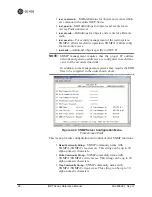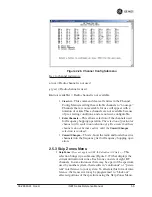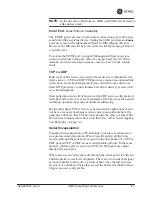
62
iNET Series Reference Manual
05-2806A01, Rev. H
One radio can perform serial data encapsulation (IP-to-Serial) and talk
to a PC. Two radios (or one radio and a terminal server) can be used
together to provide a serial-to-serial channel.
TCP Client vs. TCP Server
A TCP session has a server side and a client side. You can configure the
transceiver to act as a server, a client, or both.
TCP servers listen and wait for requests from remote TCP clients to
establish a session. A TCP client is a program running on a device other
than the TCP server. Alternately, TCP clients actively attempt to estab-
lish a connection with a TCP server. In the case of the transceiver, this
happens whenever data is received on the serial port.
The transceiver operates in either client or server mode, depending on
which event occurs first, either receiving data on the serial port, or
receiving a request to open a TCP connection from a remote client.
The transceiver keeps a TCP session open until internal timers that mon-
itor traffic expire. Once a TCP session is closed, it must be opened again
before traffic can flow.
UDP Multicast
IP provides a mechanism to do a limited broadcast to a specific group of
devices. This is known as “multicast addressing.” Many IP routers, hubs
and switches support this functionality.
Multicast addressing requires the use of a specific branch of IP
addresses set apart by the Internet Assigned Numbers Authority (IANA)
for this purpose.
UDP multicast is generally used to transport polling protocols typically
used in SCADA applications where multiple remote devices will
receive and process the same poll message.
As part of the Multicast implementation, the radio sends IGMP mem-
bership reports and IGMP queries, and responds to membership queries.
It defaults to V2 membership reports, but responds to both V1 and V2
queries.
You must configure the multicasted serial port as the target for the mul-
ticast data (for example, multipoint-to-multipoint mode, or
point-to-multipoint mode where the inbound data is multicast). This
restriction is because a host that only sends data to a multicast address
(for example, point-to-multipoint mode where the iNET acts as a point)
will not join the group to receive multicast data because the host’s
inbound data is directed unicast data.
Содержание MDS iNET 900
Страница 12: ...2 iNET Series Reference Manual 05 2806A01 Rev H ...
Страница 32: ...22 iNET Series Reference Manual 05 2806A01 Rev H ...
Страница 122: ...112 iNET Series Reference Manual 05 2806A01 Rev H ...
Страница 124: ...114 iNET Series Reference Manual 05 2806A01 Rev H ...
Страница 136: ...126 iNET Series Reference Manual 05 2806A01 Rev H ...
Страница 138: ...128 iNET Series Reference Manual 05 2806A01 Rev H ...
Страница 162: ...152 iNET Series Reference Manual 05 2806A01 Rev H ...
Страница 164: ...154 iNET Series Reference Manual 05 2806A01 Rev H ...
Страница 174: ...164 iNET Series Reference Manual 05 2806A01 Rev H ...
Страница 182: ...172 iNET Series Reference Manual 05 2806A01 Rev H ...
Страница 190: ...GE MDS LLC Rochester NY 14620 General Business 1 585 242 9600 FAX 1 585 242 9620 Web www GEmds com 175 Science Parkway ...






























